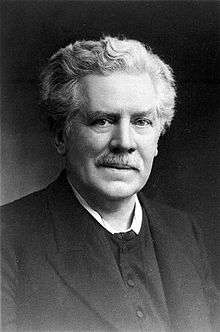Gustaf Retzius
| Gustaf Retzius | |
|---|---|
 Gustaf Retzius | |
| Born |
17 October 1842[1] Stockholm[1] |
| Died |
21 July 1919 (aged 76)[1] Stockholm[1] |
| Nationality | Swedish |
| Alma mater |
Uppsala University Lund University |
| Known for | nervous system |
| Scientific career | |
| Fields | histology, neurology |
| Author abbrev. (botany) | G.Retz. |
Prof Magnus Gustaf (or Gustav) Retzius FRSFor HFRSE MSA (17 October 1842 – 21 July 1919) was a Swedish physician and anatomist who dedicated a large part of his life to researching the histology of the sense organs and nervous system.
Life
Retzius was born in Stockholm, son of the anatomist Anders Retzius (and grandson of the naturalist and chemist Anders Jahan Retzius). He enrolled at Uppsala University in 1860, and received his medicine kandidat degree there in 1866, transferred to the Karolinska Institute, where he became medicine licentiat in 1869 and completed his doctorate in medicine (Ph.D.) in 1871 at Lund University.
He received an extraordinary professorship in histology at the Karolinska Institute in 1877 and an ordinary professorship in anatomy there in 1889 (acting from 1888), but resigned in 1890 after conflicts with other members of the institute. As he was married to the feminist Anna Hierta, daughter of the founder of the newspaper Aftonbladet Lars Johan Hierta, his personal wealth allowed him to pursue his research and writing without any stable employment. Moreover, Retzius serve as the editor of the Aftonbladet (1884–87) and was also a journalist there.
Research
Gustaf Retzius published more than 300 scientific works in anatomy, embryology, eugenics, craniometry, zoology and botany. He gave his name to the 60 micrometer-diameter Retzius cells in the central nervous system of the leech (Hirudo medicinalis).
During his time at the Karolinska Institute, he made important contributions to anatomical descriptions of the muscles of the eardrum, the bones of the middle ear, and the Eustachian tube.[1]
His 1896 2-volume work Das Menschenhirn (The Human Brain) was perhaps the most important treatise written on the gross anatomy of the human brain during the 19th century.[1]
He also studied ancient Swedish and Finnish skulls,[1] following the steps of his father Anders Retzius, who had studied the crania of different human "races" and made pseudoscientific contributions to phrenology. Retzius was one of the fathers of the pseudoscientific race theory, "scientific racism", trying to glorify the "Nordic race" as the highest race of mankind.[2]
Swedish Academy
Gustaf Retzius was politically and socially active. Together with his wife he founded the Hierta-Retzius foundation, which is now administered by the Royal Swedish Academy of Sciences, which Retzius was a member of from 1879. The foundation has two funds, one for the promotion of biological research and the other for supporting projects of an important scientific or social nature.
In 1901 Gustaf Retzius became a member of the Swedish Academy, following Adolf Erik Nordenskiöld's demise. He was also a member of the Royal Swedish Academy of Sciences. As a result, he took part in the awarding of the Nobel Prizes in Physics, Chemistry and Literature for years. However, his resignation from his chair in anatomy in 1890 meant that he could not participate directly in the choice of the Physiology or Medicine awardee; although he was an active nominator for that prize from 1901 to 1906, always including Santiago Ramón y Cajal.[3][4] In addition, he could not send nominations for the other prizes.[4]
During the decision process of the 1906 Nobel Prize in Physiology or Medicine, Retzius ardently stood up for a sole awarding to Santiago Ramón y Cajal, thus excluding Camilo Golgi. This was the same view held by Emil Holmgren in his report for the Nobel Committee. On the contrary, the evaluation by Carl Sundberg favoured Golgi over Cajal. Before the final decision, the written opinion of Bror Gadelius, who shared Holmgren's views was also taken into account. In the end, Cajal and Golgi were jointly awarded, being the first time this Prize was shared between two laureates.[3]
Retzius himself was also a Nobel Prize nominee himself 23 times, in 11 different years from 1901 to 1916. Curiously, he was nominated by Cajal before 1906 and by Golgi after that year.[4]
Death
He died in 1919 in Stockholm.[1] He was survived by his wife. His seat at the Swedish Academy was taken by Adolf Noreen that same year.
Notes
- 1 2 3 4 5 6 7 8 "Magnus Gustaf Retzius: Swedish anatomist and anthropologist". Encyclopaedia Britannica.
- ↑ Ghelichkhan, Pouya (2008). "Far och son Retzius – företrädare för en missbrukad vetenskap". Läkartidningen. 105 (21): 1597–1598.
- 1 2 Grant, Gunnar. "How Golgi Shared the 1906 Nobel Prize in Physiology or Medicine with Cajal". Nobelprize.org.
- 1 2 3 "Nomination Database: Gustaf M Retzius". Nobelprize.org.
- ↑ IPNI. G.Retz.
References
- Sjöstrand, Lars (2008). "Gustaf Retzius – great researcher and controversial cultural personality". Lakartidningen. 105 (8): 559–61. PMID 18363303.
- Hawkins, Joseph E (2005). "Sketches of otohistory. Part 6: Gustaf Retzius". Audiol. Neurootol. 10 (2): 65–68. doi:10.1159/000083361. PMID 15650297.
- Grant, G (August 1999). "Gustaf Retzius and Camillo Golgi". Journal of the history of the neurosciences. 8 (2): 151–163. doi:10.1076/jhin.8.2.151.1835. PMID 11624296.
- Grant, G (January 2000). "The histologist and anatomist Gustaf Retzius. He never received the Nobel Prize in spite of his twelve nominations". Lakartidningen. 97 (1–2): 64–70. PMID 10668335.
- Afzelius, B A (October 1995). "Gustaf Retzius and spermatology". Int. J. Dev. Biol. 39 (5): 675–85. PMID 8645550.
- HAGGQVIST, G (December 1960). "Gustaf RETZIUS". Svenska läkartidningen. 57: 3699–706. PMID 13710525.
External links
| Cultural offices | ||
|---|---|---|
| Preceded by Adolf Erik Nordenskiöld |
Swedish Academy, Seat No 12 1901-1919 |
Succeeded by Adolf Noreen |